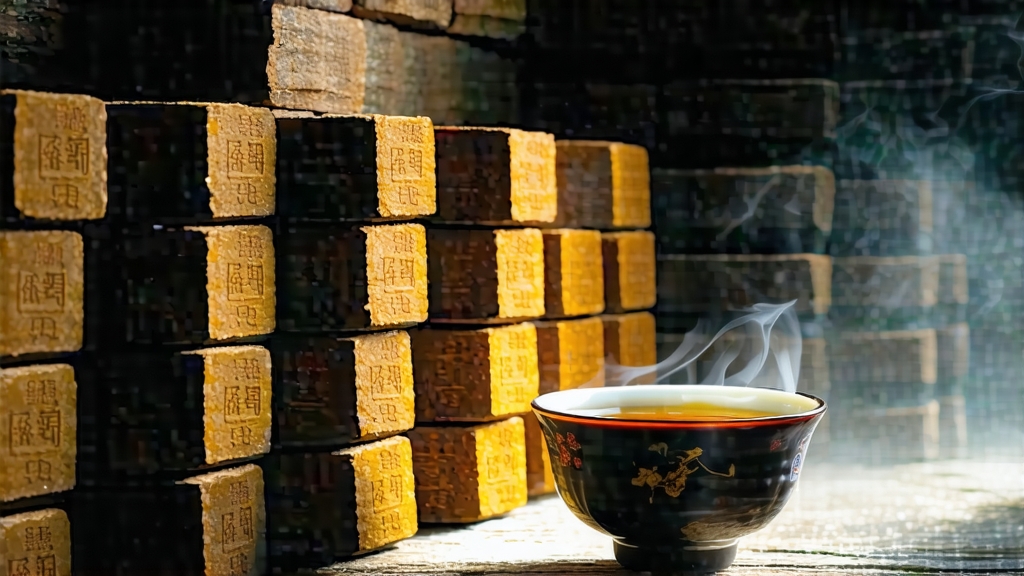
Liu Bao, literally “Six Forts,” is the quiet genius of China’s dark-tea family. While Pu-erh grabs headlines, this cousin from Guangxi Province has spent four centuries perfecting the art of graceful aging. International drinkers who meet Liu Bao for the first time often describe the encounter as “finding a cellar-aged Bordeaux in tea form,” yet its story remains largely untold outside China. This article opens the doors to that story, guiding you from the humid storerooms of Wuzhou to your own teapot.
History: From Border Currency to Maritime Gold
Liu Bao’s documented history begins in the late Ming dynasty, when tea growers in the mountainous counties of Cangwu and Tengxian compressed rough leaves into 40-kilogram baskets and traded them for salt, horses, and even land rights. The Qing imperial court soon listed Liu Bao as one of the “Royal Tribute Teas,” but its real fame came through the 18th-century Maritime Silk Road. Clipper ships departing from the Pearl River Delta carried Liu Bao to Southeast Asia, where miners in Malaya and rubber tappers in Singapore swore the tea cured dysentery and “cooled the blood” in tropical heat. In 1886 the British colonial medical journal The Straits Times reported that Chinese laborers who drank Liu Bao daily recorded lower malaria fatalities, a claim that boosted exports to 1,500 tons a year. During the Second World War Japanese blockades cut off supply; baskets were buried in caves and forgotten. When rediscovered decades later, the leaves had mellowed into a dark, woody liquor that fetched higher prices than newly made tea, giving birth to the mantra “the older, the dearer.”
Micro-Terroirs within Guangxi
Guangxi’s karst landscape creates a patchwork of microclimates. The classic “Three Rivers and Two Corridors” region—where the Xun, Gui and Liu Jiang rivers converge—traps morning mist that acts like a natural humidifier for tea warehouses. Within this zone, three sub-styles have emerged:
- Mountain Liu Bao: Grown above 600 m in Cangwu County, where diurnal swings of 10 °C slow leaf growth, yielding smaller leaves rich in amino acids. Aged versions develop orchid and longan notes.
- Valley Liu Bao: Cultivated on alluvial terraces along the Tengxian basin. Broader leaves, higher polyphenol oxidase activity, create a deeper betel-nut character after fermentation.
- Old-tree Liu Bao: Harvested from 200-year-old tea trees scattered in the Dayao Mountains. Wilder genetic stock gives camphor and pine resin top notes that persist through decades of aging.
Craft: When Humidity Becomes the Master
Unlike Pu-erh’s wodui (wet-piling) that lasts 45–60 days, Liu Bao undergoes a shorter 25–30 day “Guangxi pile-fermentation” in below-ground bamboo rooms. The process begins on the luo yu (Grain Rain) solar term when ambient humidity hovers at 85 %. Fresh leaves are wilted under moonlight—an old trick said to “invite cool yin energy”—then pan-fired at 280 °C for eight minutes to kill green enzymes. While still warm, the leaves are rolled into tight strips that rupture 70 % of cell walls, releasing catechins for microbial dinner. The critical twist is the shui gui (water return) step: workers spray a mist of mineral-rich spring water onto the piles every 12 hours, maintaining 38 °C internal temperature and pH 5.2. A native consortium of Aspergillus niger, Blastobotrys adeninivorans, and Bacillus subtilis dominates, metabolizing caffeine into the bronchodilator theacrine and converting bitter gallocatechins into mellow theabrownins. After piling, the tea is steamed, packed into 30-kilogram bamboo baskets lined with maple leaves, and transferred to “natural warehouses” built on granite slabs. Here, year-round humidity of 75 % and temperatures between 20–28 °C allow slow secondary fermentation that can last 30 years or more.
The Language of Aging
Liu Bao ages through three recognized stages:
- Young (1–5 years): Liquor the color of light soy sauce, dominant flavors of raw cacao and damp bark.